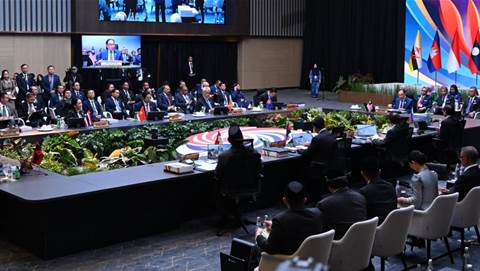The spectre of increasing protectionism is looming large from the ongoing trade wars, casting a long shadow over businesses particularly within the technology sector across the APAC region.
With the Trump administration continuing to threaten even harsher measures if countries do not respond positively or retaliate, economists warn that the uncertain and worsening trade climate can lead to a recession across many countries, with newly imposed tariffs and export controls hitting industries hard. Companies reliant on global supply chains will bear the brunt of soaring operational costs and shrinking margins, and we will likely see a dramatic shift in strategic priorities.
While an exemption on smartphone and computer parts has been temporarily made (as at press time on Apr 24), it is likely the US government will resume tariffs on all the excluded electronic parts and further implement separate tariffs on semiconductors.
Tariffs on electronic components and raw materials will raise manufacturing costs and lead to higher prices for consumer electronics and reduced demand for advanced technologies.
Markets are reacting to the supply chain uncertainty with heightened volatility, and companies in the region are preparing for a more fragmented, regulated global economy.
In the IT hardware segment, where demand for AI chips and advanced infrastructure is skyrocketing, the implications are particularly severe. Tariffs and trade restrictions could slow AI adoption, choke supply just as demand reaches unprecedented highs, derailing growth trajectories for startups and established tech giants alike. The software and service sectors will also be dragged down by the negative sentiment and subsequent cuts and delays in spending.
This month, we spoke to several industry practitioners on the front lines of these disruptions to understand the impact of fallout, how the landscape will change and the longer-term implications if the trade wars do not abate. Our respondents include:
Frederic Giron, Vice President, Senior Research Director, Forrester;
Soon Ghee Chua, Senior Partner, Kearney;
Nicholas Lee, Chair of SGTech, Singapore’s Technology Trade Association;
David Siah, Co-opted Councillor, SGTech
iTNews Asia: How do you see tariffs impacting your country or APAC businesses/tech sector in 2025?
Giron (Forrester): New US tariffs will directly inflate IT hardware costs, shrinking CIOs’ purchasing power. The immediate hit is on hardware budgets, but expect delayed price increases for cloud and SaaS platforms as providers eventually absorb these higher infrastructure expenses.
Systems integration and outsourcing partners may face indirect cost adjustments, potentially mitigated by AI efficiencies, but hardware affordability is the primary tariff-related challenge. This demands an urgent overhaul of spend management, forcing CIOs to prioritise ruthlessly and likely defer nonessential hardware upgrades.
Lee (SGTech): While technology firms may not be immediately affected by the tariffs, the broader macroeconomic repercussions will certainly have an impact. Higher tariffs can contribute to inflation and slower global economic growth, which in turn will affect consumer sentiment and business spending across the tech and multiple industries.
Supply chains are also likely to face disruption, especially where components originate from affected countries such as Vietnam and China. This could lead to increased costs for companies that sell into the US, prompting a need to diversify supply chains.
For service-based industries, the direct impact of protectionism may be less immediate, but the pressure to stay competitive especially through digital tools and skilled talent will keep growing.
In Singapore, where many tech firms are closely linked to ASEAN and the wider Asia Pacific region, the indirect effects could be stronger.

US tariffs might push exporters to redirect goods to Southeast Asia, potentially lowering prices but also making the regional market more complex. In response, some businesses may hold off on investments or shift their budgets to manage rising costs. This could mean smaller IT budgets and slower digital transformation posing challenges for local tech firms.
- Nicholas Lee, Chair of SGTech, Singapore’s Technology Trade Association
On the upside, non-US companies might find new opportunities. As some regional businesses face higher costs from US vendors, they’re already exploring alternative providers. This trend could accelerate, opening doors for others to fill the gap.
Chua (Kearney): The tariff impacts have been negative, and this is reflected in lower equity markets and reduced trade and economic forecasts in the region.
Trade volumes are expected to drop for many Asian countries, while companies in the region face rising costs. The hardest-hit will be economies that export heavily to the US like China across many industries, Japan and Korea in autos and electronics, and Southeast Asian nations that rely on Chinese parts for assembly before exporting to the US. This is why several Asian governments are now actively engaging the US in talks, and some are introducing support packages to help industries hit by the tariffs.
Uncertainty over the final terms of these tariffs is also causing delays in major business decisions, including investment and hiring. Even countries not directly targeted may feel the effects through slower economic growth across the region. And while some may benefit from relatively lower tariffs, any gains could be outweighed by weaker overall demand.
iTNews Asia: What can or should companies do to mitigate the risks?
Chua (Kearney): In the short term, companies should conduct detailed impact assessments and build models to understand how tariffs will affect them and what actions they can take to reduce that impact. This could include reclassifying products under the Harmonised Tariff Schedule (HTS) where legally possible, shifting production to lower-tariff countries if feasible, and working with customers and suppliers to share the burden. We're also seeing many companies stockpiling goods ahead of key tariff deadlines.
Looking further ahead, companies will need to rethink their commercial strategies starting with how they serve the US market. That might mean offering different products from alternate suppliers or production sites, and also reducing their reliance on US exports by expanding into other markets.
Building a more flexible and locally focused manufacturing and distribution setup will also be important. This will help companies respond better not just to US tariffs, but also to potential trade barriers from other countries as the world moves toward regional trading blocs and away from full globalisation.
Strategies like Free Trade Zone (FTZ) classification, bonded warehousing, and working with industry coalitions to seek carve-outs or tariff exemptions should all be on the table.
Giron (Forrester): Facing tariff volatility, Asian CIOs must intensify their focus on rigorous IT Financial Management (ITFM). First, achieve granular visibility across the entire IT portfolio – understanding the total cost and health of assets to inform lifecycle decisions, alongside transparent tracking of cloud consumption, software licenses, and services to pinpoint specific tariff cost inflation. They should consider investments in solutions like Software Asset Management (SAM) to help improve visibility.
Next, companies need to tighten control. Use data-driven scenario planning, factoring in possibilities like prolonged high tariffs, further escalations, or negotiated rollbacks—to guide budget forecasting during this period of uncertainty. Enforce strict, value-based criteria to all IT investments, strong governance over hardware refresh cycles, and ensure financial policies enable agile budgeting with clear contingency plans.
Finally, pursue optimisation relentlessly. Maximise the value extracted from existing assets. Implement FinOps practices rigorously to cut down on cloud waste. When planning future sourcing, don’t just look at cost but consider the full picture, including risk and long-term value. The ultimate goal is to free up capital for reinvestment in resilience and the kind of strategic innovation that will keep companies competitive in the region.
Lee (SGTech): The latest developments reinforce the need for companies to double down on long-term resilience. In the mid to long run, we must accelerate our upskilling and cross-skilling efforts to ensure our workforce remains agile and future-ready, especially in the face of evolving global economic conditions.
In Singapore, we need to push ahead with digitalisation across all sectors to raise productivity, competitiveness, and adaptability. Technologies like AI will inevitably displace some jobs, but if the country can proactively restructure industries and prepare our talent pool, we could be well-positioned to thrive in what some are calling an era of “super productivity.”
iTNews Asia: What do you think the impact will be on the supply chain of businesses in your country and the region? Do you see supply chains becoming de-globalised?
Siah (SGTech): The uncertainty surrounding trade policy has already led many companies to adopt a "wait-and-see" approach, delaying or cancelling investment decisions due to a lack of clarity around long-term supply chain costs. Although companies may initially absorb the increased operational costs, prolonged tariffs could lead to economic fatigue, workforce adjustments, and wider financial strain across industries.
In contrast, Southeast Asian countries like Vietnam, the Philippines, and Cambodia are facing even steeper tariffs. This has led to more severe job losses and economic disruptions.

While these developments might appear to signal de-globalisation, they are better interpreted as a shift toward regionalisation. Rather than dismantling global supply chains altogether, businesses are restructuring them to be more diversified and regionally focused, to reduce reliance on any one market.
- David Siah, Co-opted Councillor, SGTech
This trend is already visible through initiatives like the ASEAN Economic Community (AEC), which promotes economic integration and intra-regional cooperation among Southeast Asian nations.
Chua (Kearney): We will certainly see a deglobalisation of world trade, but the extent will depend on the final levels of US tariffs (through negotiations or retaliations) and how sustained the US tariffs will be in the face of potential domestic economic impact.
In addition, we will need to consider the impact of Chinese manufacturers that are either setting up base or exporting to the region especially Southeast Asia, as well as consider whether current and developing Free Trade Agreements (FTA) and trade arrangements such as Comprehensive and Progressive Agreement for Trans-Pacific Partnership (CPTPP) and Regional Comprehensive Economic Partnership (RCEP) will remain intact to be leveraged upon.
What we are likely to see is a further shift in the supply chain from China to countries of lower tariffs within Southeast Asia as well as further localisation and regionalisation of the trade, with an increase in intra-Asia and even intra-ASEAN trade. Asia to EU trade may also increase if the trade agreements are adhered to and both regions, particularly the EU is able to achieve higher growth through greater stimulus and consumer spending.
Giron (Forrester): The current tariff environment will accelerate a profound reconfiguration - rather than a full de-globalisation - of supply chains across Southeast Asia. The shift away from China, spurred by geopolitical risks and rising tariffs, is accelerating the "China Plus One" strategy, positioning Southeast Asia as a key beneficiary. However, while this brings increased investment and growth potential, it also introduces new complexity: infrastructure strain, rising labour costs, regulatory challenges, and continued reliance on some crucial Chinese components.

The result is a more regionally distributed and interconnected supply chain, which is harder and more expensive to manage. CIOs will need to partner closely with the business to improve visibility, strengthen risk management, and invest in more flexible systems and processes to stay competitive in this more complex environment.
- Frederic Giron, Vice President, Senior Research Director, Forrester
iTNews Asia: The 2018-2019 tariff war also had a significant impact on markets, taking them on a roller coaster ride, similar to today. In the US, it caused volatile disruptions, price and elevated uncertainty, which led to stalled capital expenditure and hiring. What do you see happening if the trade war is continued across the medium and long term of Trump’s office?
Giron (Forrester): A continuation of trade war policies, similar to the 2018-2019 period, creates significant downstream risks and budget uncertainty. Firms' key IT suppliers will face the direct impact of tariffs and geopolitical instability on their complex, often Asia-centric, supply chains. This translates into potential price volatility passed onto customers for essential hardware, unpredictable fluctuations in lead times disrupting project rollouts, and potentially limited availability of certain configurations.
Therefore, strategic IT planning requires CIOs to factor in heightened vendor supply chain risk, anticipate budget pressures stemming from these vendor cost increases and potential macro-economic headwinds. Building or strengthening robust spend management (ITFM, FinOps, SAM etc) capability is paramount to effectively navigate the next few years.
Chua (Kearney): There are multiple possible scenarios and outcomes depending on the factors explained above, and these scenarios will impact not just the supply chain, but also overall economic growth, the financial and capital markets, as well as geopolitical relationships and balance of power.

In the worst case, escalating trade wars can lead to grey zone conflicts or even kinetic war in the region (with regions such as the South China Sea and Taiwan particularly worrying), with higher prices and reduced demand sapping business and consumer confidence, and potentially resulting in recession and stagflation over multiple quarters.
- Soon Ghee Chua, Senior Partner, Kearney
In the best case, there is a de-escalation of the trade wars after an intense few months of negotiations. International trade relations stabilise, with supply chains being reorganised to take advantage of differential tariff differences as well as new trade agreements on mutual purchases.
We are likely to see the emergence of trading blocs or region-dominant supply chains (e.g. US-aligned, China-aligned supply chains) as globalisation gives way to transactional agreements between countries, sometimes with specific carve outs and treatment given to sectors or even companies.
Siah (SGTech): The 2018–2019 tariff war had far-reaching consequences for both domestic and global markets through heightened market volatility, disrupted supply chains, and increased production costs. Capital expenditure and hiring slowed significantly as many companies adopted a risk-averse and inward-looking approach amid growing economic uncertainty.
If a similar trade war happens again under a Trump presidency and stretches into the medium or long term, we can expect equally disruptive, and possibly even deeper, economic and structural impacts.
Firstly, businesses are likely to remain hesitant about long-term investments due to ongoing unpredictability in trade policy. This persistent uncertainty may restrict resources available for innovation and research, ultimately reducing operational efficiency and slowing productivity.
Hiring is also expected to plateau, especially in sectors closely linked to international trade such as manufacturing, logistics, and high-tech industries.
Secondly, prolonged tariffs are likely to reinforce inflationary pressures within the U.S. economy. Higher costs for imported goods, particularly raw materials and intermediate components, will increase production expenses for manufacturers. In many cases, these added costs may be passed on to consumers.
Globally, continued tariffs could isolate the American economy, prompting key trade partners particularly in Asia to deepen regional cooperation and reduce dependence on the US Many may pivot toward alternative trade alliances in China or the European Union.
Lastly, businesses are expected to accelerate supply chain diversification in response to tariff risks. This may include increasing investments in “China+1” strategies or “friend-shoring” to trusted allies. However, these transitions take time and may increase short-term costs for both firms and consumers.










